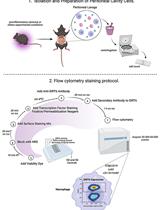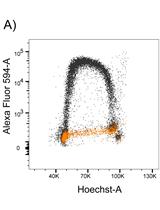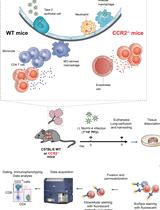- Submit a Protocol
- Receive Our Alerts
- EN
- EN - English
- CN - 中文
- Protocols
- Articles and Issues
- For Authors
- About
- Become a Reviewer
- EN - English
- CN - 中文
- Home
- Protocols
- Articles and Issues
- For Authors
- About
- Become a Reviewer
Flow Cytometric Analysis of Calcium Influx Assay in T cells
Published: Vol 3, Iss 18, Sep 20, 2013 DOI: 10.21769/BioProtoc.910 Views: 19866
Reviewed by: Anonymous reviewer(s)

Protocol Collections
Comprehensive collections of detailed, peer-reviewed protocols focusing on specific topics
Related protocols

Flow Cytometry Analysis of SIRT6 Expression in Peritoneal Macrophages
Valentina Pérez-Torrado [...] Mariana Bresque
Oct 5, 2022 1596 Views

Analysis of RNA Polymerase II Chromatin Binding by Flow Cytometry
Lilli T. E. Bay [...] Helga B. Landsverk
Apr 20, 2023 730 Views

Functional Phenotyping of Lung Mouse CD4+ T Cells Using Multiparametric Flow Cytometry Analysis
Céline M. Maquet [...] Bénédicte D. Machiels
Sep 20, 2023 574 Views
Abstract
Calcium influx is one of the key signaling events upon stimulation of T cell receptors (TCR) and plays an important role for T cell activation, proliferation, and differentiation. Phorbol myristate acetate (PMA) and calcium ionophore ionomycin are commonly utilized as stimulants in a variety of immunologic assays including T cell activation. PMA is a protein kinase C (PKC) activator, resulting in the activation of Ras, a small GPTase. When PMA and ionomycin are used together, TCR signaling downstream of PKC and Ras can be activated without activation of TCR-triggerd signaling events. This protocol describes the flow cytometry analysis of intracellular calcium influx in T cells stimulated with PMA and ionomycin.
Materials and Reagents
- Jurkat T cells (ATCC, catalog number: TIB-152 )
- DMSO (Sigma-Aldrich, catalog number: 472301 )
- RPMI media 1640 (Life Technologies, Gibco®, catalog number: 21875-034 )
- Fetal Bovine Serum (FBS) (Life Technologies, Gibco®, catalog number: 16000044 )
- Penicillin/streptomycin (pen/strep) (Life Technologies, Gibco®, catalog number: 15140-122 )
- PMA (Sigma-Aldrich, catalog number: P1585 ) (Store at -20 °C)
- Ionomycin (Sigma-Aldrich, catalog number: I0623 ) (Store at -20 °C)
- Calcium Assay Kit (BD Biosciences, catalog number: 640176 )
- Complete RPMI media (see Recipes)
- PMA stock solution (see Recipes)
- Ionomycin stock solution (see Recipes)
Equipment
- Centrifuge (Eppendorf, model: 5810R )
- 37 °C 5% CO2 Cell culture incubator
- Cell Counter
- BD CantoII FACS machine
- 5 ml round-bottom FACS tube (BD Biosciences, catalog number: 352003 )
Software
- FACS DIVA software
- FlowJo software
Procedure
- Preparation (For 4 samples)
- Preparation of Jurkat T cells:
- Count cells growing exponentially (1 x 106 per assay).
- Wash cells once with pre-warmed complete RPMI media at 200 x g for 5 min.
- Place 1 x 106 cells/250 μl of fresh complete RPMI media into a 5 ml FACS tube.
- Count cells growing exponentially (1 x 106 per assay).
- Preparation of 1x enhancing solution (from Calcium Assay Kit) (2 ml for 4 assays):
- Mix 200 μl of 10x enhancing solution with 1.8 ml of assay buffer.
- Keep it at room temperature.
- Mix 200 μl of 10x enhancing solution with 1.8 ml of assay buffer.
- Preparation of indicator (from Calcium Assay Kit):
- Equilibrate a vial of indicator (stored at -20 °C) at room temperature for 5 min.
- Add 100 μl of 100% DMSO.
- Mix well by pipetting up and down multiple times.
- Store at RT for 10 min to stabilize completely.
- Store unused indicator in a small aliquot at -20 °C until use.
- Equilibrate a vial of indicator (stored at -20 °C) at room temperature for 5 min.
- Preparation of 1x loading dye:
Mix 2 ml of 1x enhancing solution with 2 μl of indicator prepared above.
- Loading dye to cells:
Add 250 μl of 1x loading dye (prepared in step 4) into each tube containing cells.
- Incubate tube for 1 h in 37 °C CO2 Incubator.
- Cool down tube at RT for 20 min before analysis
- Preparation of Jurkat T cells:
- FACS analysis
- Open the FACS DIVA software.
- Draw a dot plot (Time is on the X-axis, and FITC is on the Y-axis).
- Place a tube to the FACS machine.
- Click “Record Data” for 1 min to obtain the basal level of signal.
- Click “Stop Acquiring” and remove the tube from the FACS machine.
- Immediately add 1 μl of stimulator [a mixture of PMA (50 ng/ml) and ionomycin (1 μg/ml)].
- Vortex briefly and place the tube back to the FACS machine.
- Click “Record Data” for additional 3 min.
- Click “Append” to attach acquired signal to the 1 min basal level of signal acquired in step 4.
- Click “Stop Acquiring” to finish the assay.
- Analyze each data with FlowJo software by choosing kinetic mode.
- Overlay sample data on the control data to display the difference of signal between the control and sample on one Figure as shown in Figure 1.

Figure 1. Intracellular Ca2+ influx in IKKγ/NEMO-deficient Jurkat T cells stably complemented with Ha-tagged IKKγ/NEMO WT or mutants (S377E, S377A, Y374D, Y374F). Cells were loaded with Ca2+ indicator for 1 h at 37 °C. Intracellular Ca2+ influx upon PMA and ionomycin (P + I) treatment was monitored for 5 min by flow cytometry analysis. Vec stands for vector control.
- Open the FACS DIVA software.
Recipes
- Complete RPMI media
RPMI containing 10% FBS and 1% penicillin/streptomycin
- PMA stock solution
50 ng/ml DMSO
- Ionomycin stock solution
1 μg/ml DMSO
Acknowledgments
This protocol is adapted from Lee et al. (2012).
References
- Lee, S. H., Toth, Z., Wong, L. Y., Brulois, K., Nguyen, J., Lee, J. Y., Zandi, E. and Jung, J. U. (2012). Novel Phosphorylations of IKKγ/NEMO. MBio 3(6): e00411-00412.
Article Information
Copyright
© 2013 The Authors; exclusive licensee Bio-protocol LLC.
How to cite
Lee, S. (2013). Flow Cytometric Analysis of Calcium Influx Assay in T cells. Bio-protocol 3(18): e910. DOI: 10.21769/BioProtoc.910.
Category
Immunology > Immune cell function > Lymphocyte
Cell Biology > Cell-based analysis > Ion analysis
Cell Biology > Cell-based analysis > Flow cytometry
Do you have any questions about this protocol?
Post your question to gather feedback from the community. We will also invite the authors of this article to respond.
Tips for asking effective questions
+ Description
Write a detailed description. Include all information that will help others answer your question including experimental processes, conditions, and relevant images.
Share
Bluesky
X
Copy link








